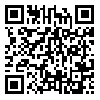Volume 82, Issue 2 (May 2024)
Tehran Univ Med J 2024, 82(2): 143-152 |
Back to browse issues page
Download citation:
BibTeX | RIS | EndNote | Medlars | ProCite | Reference Manager | RefWorks
Send citation to:



BibTeX | RIS | EndNote | Medlars | ProCite | Reference Manager | RefWorks
Send citation to:
Shahabi P, Abdolalizadeh J, Hasanpour S, Sadeghzadeh Oskouei B, Bani S. The impact of selenium and astaxanthin on sperm parameters and sensory-motor function recovery in spinal cord injured rats. Tehran Univ Med J 2024; 82 (2) :143-152
URL: http://tumj.tums.ac.ir/article-1-13040-en.html
URL: http://tumj.tums.ac.ir/article-1-13040-en.html
Parviz Shahabi1 
 , Jalal Abdolalizadeh2
, Jalal Abdolalizadeh2 
 , Shirin Hasanpour3
, Shirin Hasanpour3 
 , Behnaz Sadeghzadeh Oskouei4
, Behnaz Sadeghzadeh Oskouei4 
 , Soheila Bani *
, Soheila Bani * 
 5
5

 , Jalal Abdolalizadeh2
, Jalal Abdolalizadeh2 
 , Shirin Hasanpour3
, Shirin Hasanpour3 
 , Behnaz Sadeghzadeh Oskouei4
, Behnaz Sadeghzadeh Oskouei4 
 , Soheila Bani *
, Soheila Bani * 
 5
5
1- Department of Physiology, Faculty of Medicine, Tabriz University of Medical Sciences, Tabriz, Iran.
2- Department of Laboratory Sciences, Faculty of Para Medicine, Drug Applied Research Center, Tabriz University of Medical Sciences, Tabriz, Iran.
3- Physical Medicine and Rehabilitation Research Center, Tabriz University of Medical Sciences, Tabriz, Iran.
4- Department of Reproductive Biology, Faculty of Advanced Medical, Tabriz University of Medical Sciences Tabriz, Iran.
5- Physical Medicine and Rehabilitation Research Center, Tabriz University of Medical Sciences, Tabriz, Iran. ,banisoheila@gmail.com
2- Department of Laboratory Sciences, Faculty of Para Medicine, Drug Applied Research Center, Tabriz University of Medical Sciences, Tabriz, Iran.
3- Physical Medicine and Rehabilitation Research Center, Tabriz University of Medical Sciences, Tabriz, Iran.
4- Department of Reproductive Biology, Faculty of Advanced Medical, Tabriz University of Medical Sciences Tabriz, Iran.
5- Physical Medicine and Rehabilitation Research Center, Tabriz University of Medical Sciences, Tabriz, Iran. ,
Abstract: (126 Views)
Background: Spinal cord injury (SCI) is a significant medical and social issue, leading to varying degrees of sensory and motor impairments. Most men experience sexual dysfunction and fertility problems. These issues can be partially attributed to pathophysiological mechanisms, including damage caused by reactive oxygen species (ROS). Targeted antioxidant therapy can significantly reduce oxidative stress and neuro inflammation. This study sought to examine the impact of selenium and astaxanthin on sperm parameters and the recovery of sensory-motor function in rats with spinal cord injury (SCI).
Methods: This experimental study utilized the rat animal model and was carried out at the Neuroscience Research Center Laboratory of Tabriz University of Medical Sciences from December 30, 2022, to November 27, 2023. Fifty adults male Wistar rats were randomly allocated into five groups of ten: control, sham, SCI, selenium-supplemented, and astaxanthin-supplemented. Except for the control and sham groups, spinal cord injury was induced in all other groups. Six weeks after the injury and upon completion of the treatment, the effects of selenium and astaxanthin supplementation on sperm parameters and spinal cord repair were assessed. The Basso, Beattie, and Brenham (BBB) scale was employed to evaluate motor function, while the Von Frey test was utilized to assess sensory status.
Methods: This experimental study utilized the rat animal model and was carried out at the Neuroscience Research Center Laboratory of Tabriz University of Medical Sciences from December 30, 2022, to November 27, 2023. Fifty adults male Wistar rats were randomly allocated into five groups of ten: control, sham, SCI, selenium-supplemented, and astaxanthin-supplemented. Except for the control and sham groups, spinal cord injury was induced in all other groups. Six weeks after the injury and upon completion of the treatment, the effects of selenium and astaxanthin supplementation on sperm parameters and spinal cord repair were assessed. The Basso, Beattie, and Brenham (BBB) scale was employed to evaluate motor function, while the Von Frey test was utilized to assess sensory status.
| Results: A considerable rise in sperm concentration was noted in both the selenium-fed group and the astaxanthin-fed group when compared to the spinal cord injury group (P=0.001). Supplementation with selenium and astaxanthin improved sperm concentration, progressive motility, and viability, bringing these parameters close to control levels (P<0.001). However, neither of these substances had an effect on abnormal sperm morphology (P>0.05). Both selenium and astaxanthin supplementation enhanced the motor and sensory functions of the injured rats (P<0.001), with selenium showing a greater role in promoting repair compared to astaxanthin (P<0.001). Conclusion: Selenium and astaxanthin supplements improved sperm parameters, except for sperm morphology, and were effective in enhancing motor and sensory functions after spinal cord injury. Selenium was found to be more effective than astaxanthin in promoting spinal cord repair. |
Type of Study: Original Article |
Send email to the article author
| Rights and permissions | |
 |
This work is licensed under a Creative Commons Attribution-NonCommercial 4.0 International License. |



